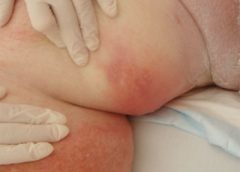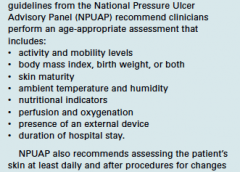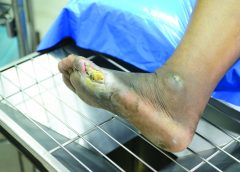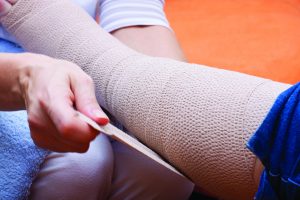Support surfaces are consistently recommended for the prevention and treatment of pressure ulcers. So patients can derive optimal benefits from support surfaces, clinicians must understand how to use them effectively. This article answers several questions about these useful tools. (more…)
Read MoreSearch Results for: tools
Buzz Report: Latest trends, part 2
Keeping clinicians up-to-date on clinical knowledge is one of the main goals of the Wild on Wounds (WOW) conference held each September in Las Vegas. Every year, I present the opening session, called “The Buzz Report,” which focuses on the latest-breaking wound care news—what’s new, what’s now, and what’s coming up. I discuss new products, practice guidelines, resources, and tools from the last 12 months in skin, wound, and ostomy management.
In the January issue, I discussed some of the updates from my 2015 Buzz Report. Now I’d like to share a few more, along with some of my favorite resources. (more…)
Read MoreBuzz Report: Latest trends, Part 1
We all lead busy lives, with demanding work schedules and home responsibilities that can thwart our best intentions. Although we know it’s our responsibility to stay abreast of changes in our field, we may feel overwhelmed when we try to make that happen.
Keeping clinicians up-to-date on clinical knowledge is one of the main goals of the Wild On Wounds (WOW) conference, held each September in Las Vegas. Each year, I present the opening session of this conference, called “The Buzz Report,” which focuses on the latest-breaking wound care news—what’s new, what’s now, what’s coming up. I discuss innovative new products, practice guidelines, resources, and tools from the last 12 months in skin, wound, and ostomy management. This article highlights the hottest topics from my 2015 Buzz Report. (more…)
Read MoreDon’t go it alone
A fundamental rule of wound care is to treat the “whole” patient, not just the “hole” in the patient. To do this, we need to focus on a holistic
approach to healing, which means evaluating everything that’s going on with the patient—from nutrition, underlying diseases, and medications to activity level, social interactions, and even sleep patterns.
We know that as specialists, we’re expected to do all of these things. But in the real world, we can’t be specialists in all areas. That’s where the team concept comes in. In fact, the team approach is imperative for helping us heal our patients’ wounds and achieve our overall goal of improving patient outcomes. (more…)
Read MoreClinician Resources: Ulcer Prevention, CAUTI, Negative Bacteria
Start the New Year off right by checking out these resources.
Pressure ulcer prevention education
Access the following education resources from Wounds International:
The webinar “Real-world solutions for pressure ulcer prevention: Optimising the role of support surfaces” includes:
• an overview of the issue of pressure ulcers
• what to consider when choosing a support surface
• how to operationalize support surfaces in the clinical setting. (more…)
Read MoreProviding skin care for bariatric patients
By Gail R. Hebert, MS, RN CWCN, DWC, WCC, OMS
How would you react if you heard a 600-lb patient was being admitted to your unit? Some healthcare professionals would feel anxious—perhaps because they’ve heard bariatric patients are challenging to care for, or they feel unprepared to provide their care. (more…)
Read MoreRole of the ostomy specialist clinician in ileal pouch anal anastomosis surgery
By Leanne Richbourg, MSN, RN, APRN-BC, CWON-AP, CCCN, GCNS-BC
Restorative proctocolectomy with ileal pouch anal anastomosis (IPAA) is the gold standard for surgical treatment of ulcerative colitis (UC) or familial adenomatous polyposis (FAP). It’s also done to treat colon and rectal cancers, such as those caused by Lynch syndrome (LS). IPAA allows the patient to maintain fecal continence and evacuate stool from the anus after colon and rectum removal. A temporary ileostomy may be part of the overall process, but there’s no need for a permanent stoma. (See Understanding ulcerative colitis, FAP, and Lynch syndrome.) (more…)
Read MorePreventing pressure ulcers in pediatric patients
By Roxana Reyna, BSN, RNC-NIC, WCC, CWOCN
As wound care clinicians, we are trained—and expected—to help heal wounds in patients of any age and to achieve positive outcomes. Basic wound-healing principles apply to all patients, whatever their age or size. The specific anatomy and physiology of vulnerable pediatric patients, however, requires detailed wound care. Unfortunately, little evidence-based research exists to support and direct the care of pediatric patients with pressure ulcers. This article describes efforts to reduce pressure ulcers in pediatric patients at Driscoll Children’s Hospital (DCH) in Corpus Christi, Texas. (more…)
Read MoreClinical Notes: Revascularization, Amputation Risk Score
Leg revascularization fails to improve outcomes in nursing home patients
Lower-extremity revascularization often fails to improve outcomes in nursing home patients, according to an article in JAMA Internal Medicine.
“Functional outcomes after lower extremity revascularization in nursing home residents: A national cohort study” found that few patients are alive and ambulatory a year after surgery, and those who are alive have little, if any, gain in function. The study, which included 10,784 patients, was based on data from nursing homes participating in Medicare or Medicaid. (more…)
Read MoreCreating high-performance interprofessional teams
By Terry Eggenberger, PhD, RN, CNE, CNL; Rose O. Sherman, EdD, RN, NEA-BC, FAAN; and Kathryn Keller, PhD, RN
Kate Summer, a wound care clinician in a urban hospital, is leading an initiative to reduce pressure ulcers. She knows from experience that more effective communication and collaborative planning by the interdisciplinary team managing these patients is crucial for reducing pressure ulcers. But doing this has been challenging for Kate. (more…)
Read MoreGet the ‘SKINNI’ on reducing pressure ulcers
By Cindy Barefield, BSN, RN-BC, CWOCN
Like many hospitals, Houston Methodist San Jacinto Hospital uses national benchmarks such as the National Database of Nursing Quality Indicators (NDNQI®) to measure quality outcomes. Based on benchmark reports that showed an increased trend of pressure ulcers in critically ill patients in our hospital, the clinical nurses in our Critical Care Shared Governance Unit-Based Council (CCSGUBC) identified an improvement opportunity. (more…)
Read MoreClinician Resources: March-April 2015
Below are resources you may find helpful to your practice.
AHRQ’s Safety Program for Nursing Homes: On-Time Prevention
The Agency for Healthcare Research and Quality (AHRQ) has established “AHRQ’s Safety Program for Nursing Homes: On-Time Prevention,” designed to improve long-term care by turning daily documentation into useful information that enhances clinical care planning.
On-Time uses electronic medical records to develop weekly reports that identify residents at risk for common adverse events in nursing homes to help clinical staff intervene early. Facilitators help the team integrate these reports into clinical decision making to improve care planning.
For each adverse event, the website provides a description of the reports and suggested meetings and huddles where the reports may be used, the functional specifications for programming the reports, description of implementation tools, and a 2-day training curriculum for facilitators.
Sleep times guidelines
The National Sleep Foundation has issued new recommendations for appropriate sleep durations. Check below to see if your patients—and you—are getting enough sleep:
• newborns (0-3 months): 14-17 hours
• infants (4-11 months): 12-15 hours
• toddlers (1-2 years): 11-14 hours
• preschoolers (3-5 years): 10-13 hours
• school-age children (6-13 years): 9-11 hours
• teenagers (14-17 years): 8-10 hours
• younger adults (18-25 years): 7-9 hours
• adults (26-64 years): 7-9 hours
• older adults (65+ years): 7-8 hours.
Access “National Sleep Foundation’s sleep time duration recommendations: Methodology and results summary” in Sleep Health.
Venous ulcer resources
The website for the Association for the Advancement of Wound Care (AAWC) has several resources related to venous ulcers:
• AAWC Venous Ulcer Guideline 3.12
• AAWC Venous Ulcer Guideline Evidence 6.13
• AAWC Venous Ulcer Guideline Algorithm Presentation 8.13
• AAWC Venous Ulcer Guideline Checklist 7.13.
The resources are available at no cost.
Wound care app
The Johnson & Johnson Wound Care Resource™ App helps patients identify, track, and provide recommendations on wound care treatment.
The free app includes treatment videos and coupons to help patients save on wound care treatment supplies. The app is available for download on iTunes.










